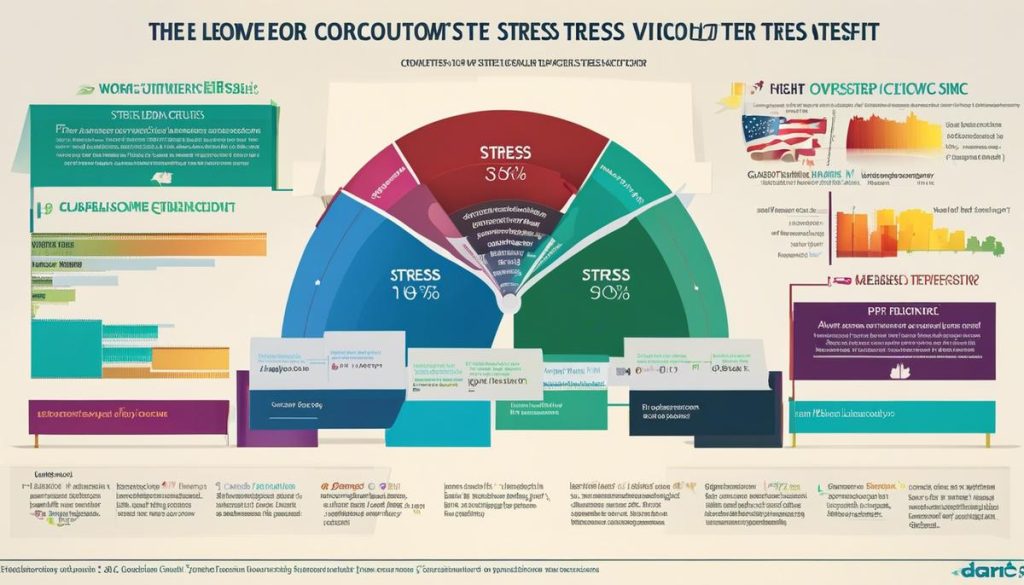The Federal Reserve’s annual stress tests serve as a critical barometer for the health and resilience of the United States’ largest banks. Through the deployment of meticulously crafted hypothetical scenarios, these tests provide a robust examination of the financial institutions’ capacity to withstand sudden and severe economic downturns. This essay dives into the heart of the stress test, unveiling its comprehensive methodology and dissecting its intrinsic value in safeguarding the stability of our financial ecosystem. As we turn our attention to the 2023 hypothetical stress test scenarios, we will explore a range of macroeconomic shocks and financial stresses, dissecting their potential to test the mettle of the banking sector and, by extension, their influence on the nation’s economy.
Unlocking the Mysteries of the Federal Reserve’s Annual Stress Test
In the complex world of finance, few entities wield as much influence as the Federal Reserve. Among its many roles is conducting an annual stress test, a rigorous assessment designed to ensure that major banks can withstand economic storms. If financial fitness and resilience are the goals, then the stress test is the Fed’s version of a high-stakes treadmill workout for banks, pushing limits to guarantee they won’t fold under pressure.
At its core, the Federal Reserve’s annual stress test is a health check-up for the country’s biggest banks. Institutions are put through hypothetical doomsday scenarios that include sky-high unemployment, plummeting property values, and stock market crashes. Think of it like a financial fire drill—banks must show they can keep cool and stay solvent, even if the economy is ablaze.
Why is this such a big deal? For starters, everyone with a stake in the economy—from Wall Street tycoons to the average Joe with a savings account—relies on the strength of these financial behemoths. Memories of the 2008 financial crisis loom large, a cautionary tale of what happens when banks aren’t prepared for a downturn. The stress test aims to prevent history from repeating itself.
Diving into the specifics, banks must submit a detailed Capital Plan, showing they have enough capital on hand to absorb losses and keep lending during tough times. Regulatory agencies, armed with data and predictive analytics, run their own simulations to see if these plans hold water. Banks that pass can breathe easy, while those that fail might need to shore up their finances or face restrictions on dividends and share buybacks.
What’s the payoff for acing the test? Banks in good standing are given the green light to distribute profits to shareholders, a signal to the market that they’re not just surviving, but thriving. On the other hand, falling short can lead to a hit on a bank’s stock price and reputation, not to mention regulatory headaches.
It’s not all about the bottom line, though. The stress test also serves a public good, fostering transparency and public confidence in the financial system. By demonstrating their economic endurance, banks play a crucial role in maintaining a stable and functional economy. It’s a financial domino effect where stability trickles down, impacting everyone from corporate juggernauts to mom-and-pop shops.
In this whirlwind of economic resilience, the Federal Reserve’s annual stress test holds a mirror up to banks, reflecting their ability to navigate financial hurricanes. It’s a testament to the power of preparedness, a bulwark against economic uncertainty, and ultimately, a safeguard for a healthier financial future for all.
Details of the 2023 Hypothetical Stress Test Scenarios
Exploring 2023’s Stress Test Scenarios: Key Factors Shaping Financial Resilience
In an ever-evolving economic landscape, the contours of the 2023 stress test scenarios draw upon a complex tableau, highlighting the necessity for robust financial fortifications. Let’s zero in on the critical components shaping this year’s gauntlet laid before the banking titans vying for a demonstration of unwavering strength.
Macroconomic Variables and Risk Assessment:
Central to the stress test narratives is a set of macroeconomic variables. These indicators constellate to forecast a gamut of trials which banks must deftly navigate. Inflation rates swinging like a pendulum, unemployment surges morphing the workforce, and GDP growth undergoing seismic shifts all converge in setting the stage. Banks must showcase adeptness in contending with economic headwinds that could precipitate a market maelstrom.
Market Shock Scenarios and Reaction Metrics:
The current market pulse beats with unpredictability, making it imperative for stress tests to scrutinize banks’ resilience against sudden shocks. Equity market crashes, nosediving property values, and foreign exchange volatility are but a few harbingers foretelling potential turmoil. Through rigorous scenario planning, banks bare their contingency stratagems, affirming that they can endure even the most cataclysmic financial quakes.
Operational Risk and Cybersecurity Threats:
As the digital tapestry weaves deeper into the fabric of finance, operational risks, especially cybersecurity breaches, loom larger than ever. This year, stress tests cast a discerning eye on banks’ digital ramparts. Without ironclad cyber defenses and impeccable risk management, a bank’s fortification crumbles, leaving them vulnerable to the whims of nefarious cyber entities.
Credit Exposure and Asset Quality:
At the heart of these stress tests lies a scrutinizing lens aimed at credit exposure. The scope of loan portfolios and their inherent riskiness are laid bare, reflective of a bank’s lending acumen. Asset quality, a mirror to a bank’s soul, must sparkle even under duress. Elevated loan defaults and precipitous falls in asset values serve up a formidable proving ground, testing the mettle of the credit operations.
Liquidity Ratios and Funding Stability:
Like the lifeblood that courses through veins, liquidity remains the lynchpin of fiscal health. The spotlight turns to liquidity ratios and banks’ ability to maintain a stable funding profile amidst a financial typhoon. Ensuring cash and its equivalents flow unimpeded, even as markets roil, positions a bank to not just survive, but to thrive when others falter.
Operational Endurance and Real-world Adaptability:
Perhaps the crowning piece of these stress tests is their capacity to validate banks’ operational endurance and adaptability in real-world chaos. A bank’s prowess is gauged not just by theoretical resistance but by its nimbleness to pivot, its savvy to innovate, and its readiness to transform challenges into opportunities. Those emerging triumphant from the turmoil demonstrate an exceptional blend of resilience, adaptability, and strategic foresight.
As banks brace for this year’s collegiate of challenges, the 2023 stress test scenarios unfold as both an odyssey and a crucible. Through stringent evaluation of these key factors, the financial fortress is hardened, presenting a bulwark against the specter of economic tumult. In this grand theater of monetary might, only the thoroughly prepared and strategically sound will transcend the crucible’s roar, standing as paragons of unwavering financial stewardship.

Impact on the Banking Sector
Stress Test Scenarios: The Critical Impact on Banking Operations
In the fast-paced world of finance, a bank’s ability to withstand economic downturns is not just important—it’s imperative. The annual stress tests mandated by the Federal Reserve are not just hoops to jump through; they are vital checks and balances that ensure the robustness of banks in the face of potential financial turmoil.
Under these tests, banks are thrown curveballs filled with adverse conditions—like spikes in unemployment or plummeting housing prices—to gauge their resilience. It’s not merely an exercise in hypotheticals; it’s a front-row seat to a bank’s strategic playbook, revealing how their decisions ripple through operations during times of stress.
The operational mechanics of a bank under pressure are complex but crucial. Consider, for example, how a bank’s day-to-day operations adapt when capital adequacy is threatened. They may tweak credit policies, tightening the reins on lending, which in turn could impact consumer spending and business expansion—key drivers of economic growth.
Or think about the domino effect on liquidity management. A stress scenario might show a need for a stronger liquidity cushion, leading to shifts in investment strategies and reserves, all to avert a cash crunch. These swift moves to safeguard liquidity highlight a bank’s agility but also underscore a deep interconnectedness with the broader market’s ebb and flow.
At the granular level, stress tests extend their reach into risk modeling and crisis response planning. A market shock would test not just the financial fortitude but also the operational readiness of an institution. Whether it’s responding to a cybersecurity breach as part of an operational risk evaluation or adjusting portfolios in response to credit risk reassessment, banks must demonstrate that their countermeasures are not just theoretical but executable—and effective.
Moreover, in the high-stakes environment of banking, reputation is currency. Passing the stress test is a public endorsement of a bank’s stability. It reassures investors and customers alike that the institution won’t just survive but can thrive amid tumultuous economic currents.
Ultimately, the stress test transcends its role as a regulatory checkpoint. It’s a pulse-check on a bank’s most critical life-support systems. From capital deployment to risk mitigation, its outcomes influence every strategic pivot and operational maneuver within the banking sector. It dictates not just survival strategies but informs forward-thinking growth plans that ensure banks aren’t merely weathering storms but are also poised to capture the sunshine that follows economic turbulence.
With each passing year, these stress scenarios evolve, serving as a potent reminder that agility in operations, robust capital planning, and a proactive approach to risk management aren’t optional for banks—they’re essential. The linchpin in a global economy that prizes stability, the focus remains steadfast on not just measuring up but setting new benchmarks of resilience in banking.

Innovation and Adaptation in Financial Services
Banks and Innovation: Navigating Stress Tests with Smarter Strategies
In a financial landscape brimming with uncertainty, banks are steering the ship with more than just a hand on the wheel—innovation is the compass guiding them through the choppy waters of stress tests. As these financial institutions face stringent evaluations, their adaptability and innovative responses are put under the microscope. Thriving in the market necessitates a blend of foresight, agility, and technological prowess.
As the pressure to perform mounts, banks are leveraging technology to gain an edge. Sophisticated analytical tools are reshaping risk management frameworks, making them not only resilient but also prescient. By incorporating AI and machine learning, banks are fine-tuning their predictive capabilities, ensuring they’re not caught off guard by future economic tsunamis.
Banks are embracing digital transformation at their core. This isn’t just about having a sleek app or an online interface; it’s about reinventing customer interactions and internal processes. From digital-only banks that slash overheads and pass on the benefits to consumers to traditional banks that incorporate blockchain for secure, transparent transactions—innovation in service delivery is pushing the envelope.
However, innovation must go beyond the front end. Operational resilience is crucial. By deploying advanced cyberdefense mechanisms and robust data protection protocols, banks demonstrate to regulators that they are safeguarding the fortress. This builds trust with the Fed and the market, showing that they’re equipped to withstand cyber onslaughts—an integral part of the modern stress test.
Another dimension where innovation is crucial is in liquidity management. The ability to pivot and rebalance portfolios instantly in response to market changes is a game-changer. Banks that harness real-time data analytics to improve their liquidity forecasts are showing that they can stay afloat even when the financial waters whirl.
But the innovation buck doesn’t stop here. It’s about building a culture that encourages dynamic problem-solving and an entrepreneurial approach to regulatory challenges. Banks are setting up incubators and innovation labs, partnering with fintech startups, and sometimes even acquiring them outright. It’s a melding of institutional stability with startup agility, creating a hybrid model that’s robust yet flexible enough to take on the uncharted territory.
Collaboration across the industry is also essential. In a symbiotic ecosystem, banks, regulatory bodies, and fintech firms engage in continuous dialogue, shaping policies and practices that recognize and address emerging threats. These collaborations can lead to breakthroughs in regulatory technology (regtech), further streamlining the stress test compliance process.
Customer-focused innovation is yet another pillar. As customer behavior evolves, banks are not only anticipating needs but also nurturing financial literacy. Savvy banks are empowering customers with tools and education to make informed choices. This positions them as partners in customers’ financial well-being, building loyalty and a foundation for sustainable growth.
To close, the banks that excel in the stress test arena are those that view the challenge not merely as a regulatory hurdle but as an opportunity for growth. They are institutions that embed innovation into their DNA. They thrive by extracting insights from stress test data, making them better equipped for the future. These banks are not just surviving the financial storm; they are the vanguard, setting new standards for the industry. By recognizing that innovation is pivotal, they transform stress tests from a stringent exam into a springboard for excellence.

Implications for the Broader Economy
Unlocking the Implications: Stress Test Outcomes and the Wider Economic Horizon
In the high-stakes realm of financial stability, stress test results are far more than a regulatory checkbox—they’re a vital health monitor for the broader economy. Let’s peel back the layers to understand the dynamic interplay between these rigorous examinations and the economic landscape at large.
Firstly, stress test results offer invaluable insight into the resilience of financial institutions against economic shocks. In essence, they are the financial world’s barometer, gauging the robustness of banks in the face of hypothetical downturns. Robust banks suggest an economy with strong financial underpinnings, capable of withstanding turbulence without buckling.
Think of it as a stress test shaping the contours of economic confidence. When institutions showcase strong results, it bolsters investor sentiment and encourages market stability. A bank fortified against potential crises can lend more freely, acting as a conduit for economic expansion through business loans and consumer credit. It’s a ripple effect: Well-capitalized banks mean well-oiled economic machinery.
Now, let’s scratch beneath the surface. The outcomes of these financial fire drills don’t just signal immediate stability; they sketch a trajectory for future economic pathways. Consistently positive stress test results may telegraph a green light for central banks to tweak interest rate strategies. Conversely, a pattern of marginal performances could warrant a more guarded fiscal approach.
On the flip side are the intricate links between stress test performance and regulatory responses. Solid outcomes may give regulators the confidence to ease certain financial constraints, paving the way for innovative growth strategies within banks. Such an environment can foster groundbreaking financial products and solutions, further energizing the economy.
Progressing further into the intricacies of the stress test ‘report card’, we can’t ignore its role as a strategic roadmap for institutions. Banks that understand the nuances of their stress test performance possess a strategic compass, one that guides enhanced risk management, operational dexterity, and fortification against future crises.
Lasty, we must consider the consumer angle. The transparency resulting from these tests engenders trust. Consumers with faith in their financial institutions are more inclined to invest, save, and spend—a cocktail of activities that fuels economic growth.
And let’s not forget, passing these tests is akin to wearing a badge of honor—financial institutions can proclaim their strength and stability, which can influence mergers, acquisitions, and competitive dynamics in the industry.
So, what do these cerebral financial exercises mean for the broader economy? They’re a weathervane for economic storms, a beacon guiding policy, a compass for fiscal navigation—and ultimately—a reflection of an economy’s capacity to navigate the unpredictable rapids of global financial waters.
Whether a stress test culminates in a robust thumbs-up or raises regulatory eyebrows, one thing is certain—their outcomes are a critical cog in the economic wheel, one that helps keep the engine of commerce churning with conviction and calculated foresight. With a keen eye on these results, the financial ecosystem can brace for, adapt to, and thrive within the ever-evolving economic climate.

Strategic Insights for Business Leaders and Investors
Entrepreneurs and investors, two dynamic forces in the contemporary business landscape, find themselves at the helm of market innovation and financial acumen. As navigators in an ocean of economic fluctuance, the insights yielded by the annual stress test are akin to the compass essential for charting a course towards sustainable profitability and strategic stability.
Tapping into Stress Test Insights for Business Agility
In a world that’s perpetually shifting, businesses require a keel robust enough to weather storms of market volatility while remaining agile. Stress test insights provide an invaluable glimpse into potential chokeholds within the financial sector, allowing entrepreneurs and investors to anticipate shifts and strategize accordingly. While banks endure hypothetical economic turmoil, businesses can parallel this approach, scrutinizing their operational models against similar adverse scenarios to enhance resilience.
Strategic Allocation of Investment Capital
Every ship requires a detailed map, and for investors, stress test insights serve as a financial cartography of sorts, signaling safe harbors and treacherous waters. By discerning how banks allocate capital under duress, investors refine their investment allocation strategies, concentrating efforts on ventures and industries showcasing robust contingency planning and crisis management.
Innovation in Risk Mitigation and Management
Navigating through tumultuous economic seas demands an entrepreneur’s foresight to embrace innovative risk management strategies. Gleaning learnings from stress tests propels businesses to innovate, incorporating predictive analytics into their own risk assessment protocols. Investors, meanwhile, look favorably on entities that can exhibit their stability in potential future crises, directing their funds toward those emulating banking standards in risk preparedness.
Building Endurance through Capital Adequacy
Much like a ship’s ballast stabilizes the vessel, capital adequacy is the ballast for a company’s financial stability. Entrepreneurs and investors should leverage stress test outcomes to evaluate their capital readiness, gearing up to withstand fiscal adversities. Fortifying financial defenses ensures operational endurance, enticing risk-averse investors seeking assurance in capital sufficiency.
Implementing Forward-looking Growth Policies
As thrivers and survivors in the business arena, entities must exhibit the ability to pivot and adapt. Stress test findings can inform growth policies that are responsive rather than reactionary. For the judicious investor, the ability of a business to use stress test models in policy formation is a clear indicator of long-term viability and growth potential.
In conclusion, entrepreneurs and investors who are adept at utilizing stress test insights can upgrade their business acumen to celestial levels. The wisdom distilled from stress tests is not merely a light guiding banks but a beacon illuminating the path for all businesses striving for enduring success in an unpredictable financial universe. With this navigational prowess, businesses and investors alike can set sail towards the horizon of progress with confidence and strategic proficiency.

As we step back and consider the myriad of insights gleaned from the Federal Reserve’s stress tests, it is evident that these exercises are much more than mere regulatory hurdles for banks. They are a testament to the dynamic landscape of financial services, influencing not just banks and their operations but also the broader contours of our economy and the decisions of investors and business leaders. Embedded within these analyses lie strategic tenets that guide stakeholders through the treacherous terrain of economic uncertainties. Therefore, understanding and acting upon these insights is not only prudent for those directly involved in the financial sector but also for anyone invested in the pulse and direction of our economy.

